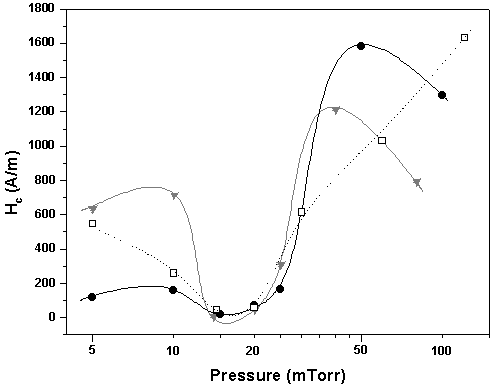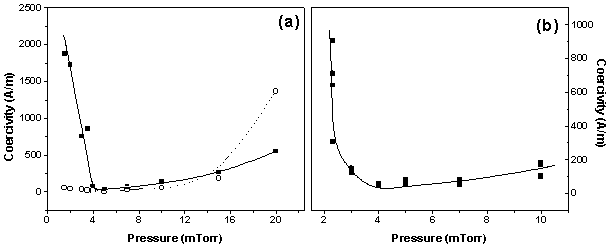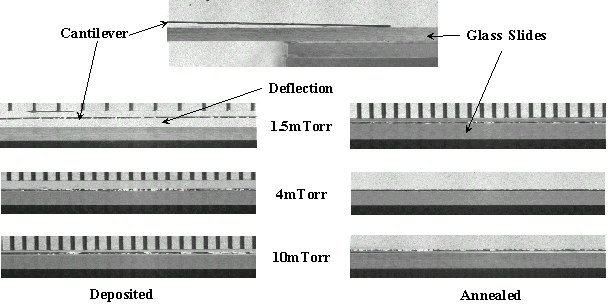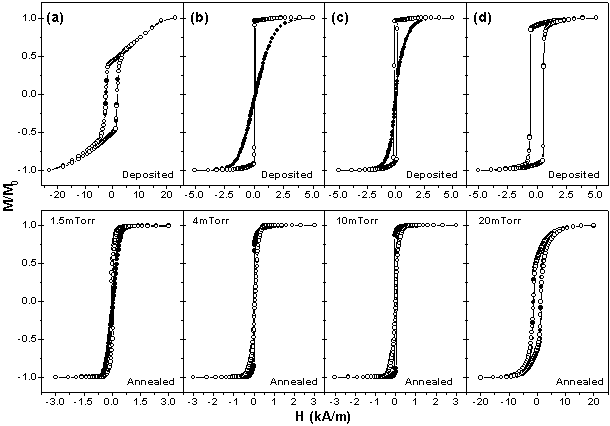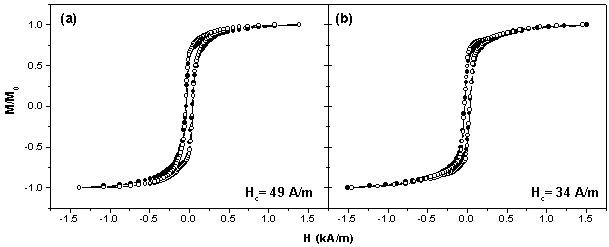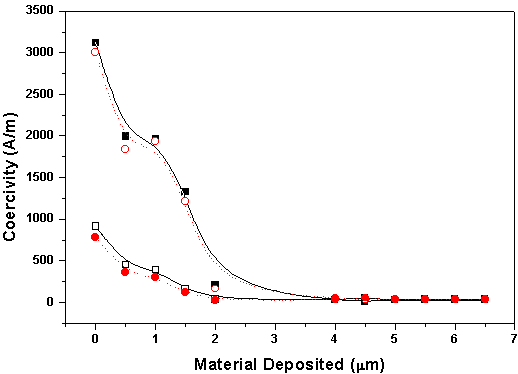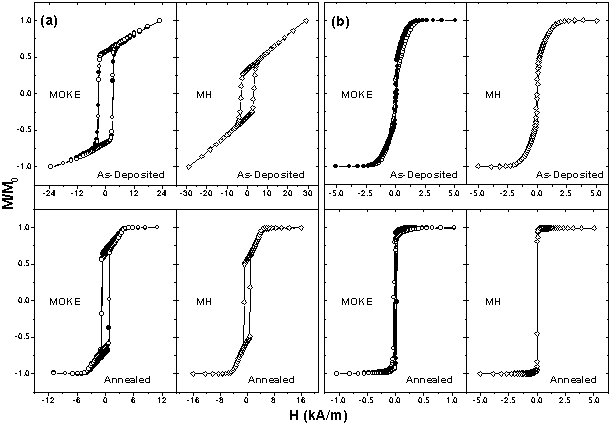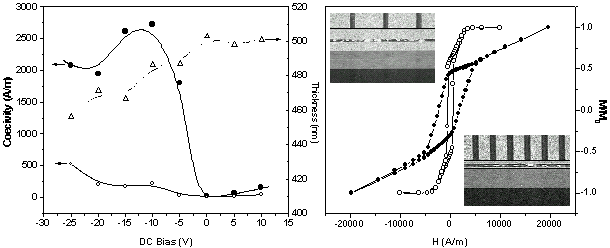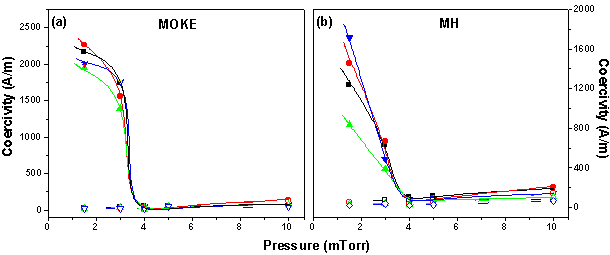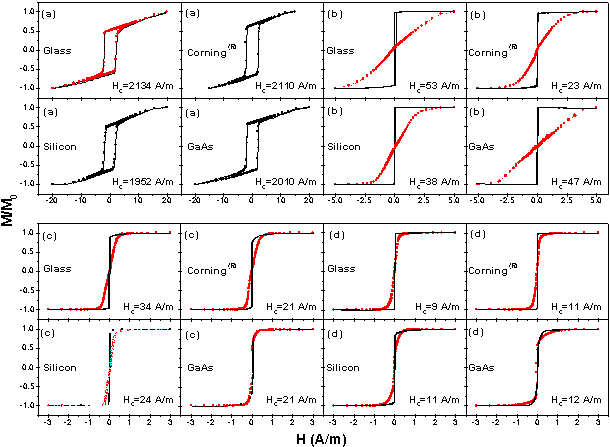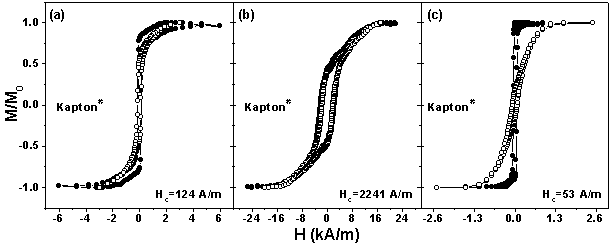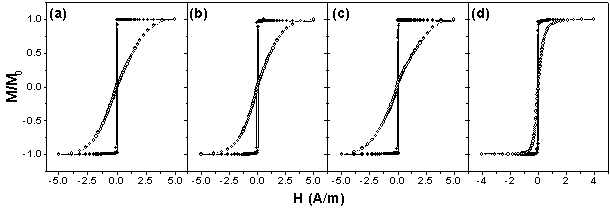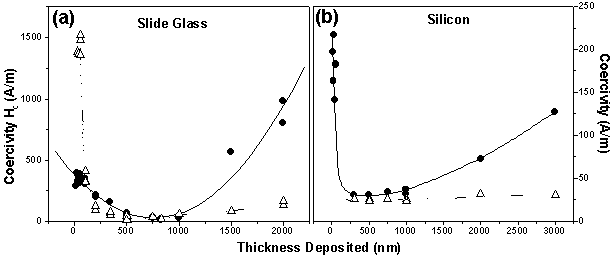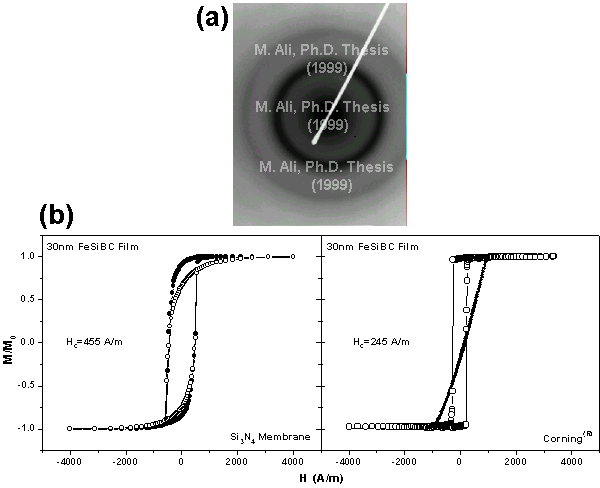| Email:Mannan.Ali@physics.org | Chapter 4: Thin Film Deposition |
|---|---|
| Web: http://members.xoom.com/MannansZone/thesis.html |
4.0 Thin Film Deposition
The process of sputter deposition for the production of thin films in an increasing number of applications has increased widely in popularity. This is due to its ease of operation, accurate control of the growth rate (thickness), excellent film adhesion and a high degree of reproducibility of the deposited films.
This chapter is concerned with the deposition and optimisation of the magnetic properties of amorphous FeSiBC thin films which have been sputtered deposited from METGLAS® 2605SC (Fe81Si3.5B13.5C2) ribbon targets, which were obtained from Allied Signal. The objective of this study was to obtain films which exhibited similar magnetic properties to those of the ribbon material. The results and findings presented here were obtained using radio frequency (RF) magnetron sputter deposition. An overview of sputter deposition of thin films is also presented, in order to highlight the problems of which one needs to be aware in the deposition of amorphous thin films, along with their general properties.
4.1 Introduction
Since it was first discovered that melt-spun, amorphous, transition metal-metalloid alloys had excellent soft magnetic properties, there has been a tremendous amount of work done on these materials with a view to optimising their magnetic properties. The properties for Fe, Co and Ni based amorphous melt-spun alloys has been extensively documented [Luborsky (1980)], and commercial organisations such as Allied-Signal and Vacuumschmelze now produce a large range of melt-spun alloys. These are used in a wide variety of modern electrical and electronic applications. See Ref. List (4.1) for further information on types of applications where magnetic materials are used.
Because of their soft magnetic properties melt-spun materials in the form of ribbons and wires (see Chapter 6) have also been exploited as stress and field sensors [Lenz (1990)]. Despite the wide availability of such materials in ribbon or wire form, in their current form they still have a number of disadvantages for modern sensor applications. Generally, the as-cast, melt-spun ribbons suffer from random residual stresses induced during the production stage. This has the effect of degrading the magnetic properties, especially if the material has a large magnetostriction, which is needed for stress-based sensors. This can lead to complex, random domain structures, which complicates both the understanding of the magnetisation process within the material and the output from the sensor itself. Ideally, for stress-based sensors, the domain structure should be orientated perpendicular to the direction of the applied stress to maximise the magnetoelastic effect (ls>0), or, in the instance of magneto impedance sensors, perpendicular to the applied current (see MI). This problem is overcome by annealing the ribbons in a magnetic field; this reduces the as-cast, random, residual stresses and induces a uniaxial domain structure. In many instances, the ribbon material is usually bonded to a rigid surface, depending on the type of sensor (i.e. Cantilever type sensor [Mitchell et al (1986)]), which can induce extrinsic random stresses because of distortions introduced when the adhesive dries; this can alter the optimised domain structure previously induced by field annealing. The annealing of some
| Growth and study of magnetostrictive FeSiBC thin films, for device applications, Mannan Ali (1999) | 49 | |
|---|---|---|
| (Online Copy) |
| Email:Mannan.Ali@physics.org | Chapter 4: Thin Film Deposition |
|---|---|
| Web: http://members.xoom.com/MannansZone/thesis.html |
ribbons, such as the METGLAS® 2605SC ribbon used in this thesis as the target material, has the undesirable effect of degrading the ductility. In most instances, this not a problem, since the ribbon is usually bonded to a rigid surface, where the stresses transmitted from the rigid surface to the ribbon are relatively small.
However, advances in technology generally mean some form of miniaturisation. Sensors are now being integrated and microfabricated onto commercially important substrates such as silicon and gallium arsenide in such ways that they are compatible with conventional microelectronic fabrication. This allows all the components required for the sensor device to operate to be fabricated on the one substrate. To keep in step with such developing technologies, the potential of these amorphous alloys are now being exploited in thin film magnetic sensors. Magnetic thin films also allow the fabrication of more exotic, three dimensional structural sensors, such as membranes [Karl et al (1999)] and cantilevers [Karl et al (1999a)] on a micron scale. Ribbon materials in their current form would be difficult to incorporate into such small sensor elements. By no means does this mean that magnetic thin films do not pose any problems of their own. The magnetic and structural properties of thin films are strongly dependent upon the deposition process and the parameters under which the film is deposited. Sputtering and evaporation techniques are the two common methods of preparing amorphous magnetic thin films, with the former being the most popular of the two. To achieve device quality thin films with similar magnetic properties to that of the ribbon materials, three main requirements need to be fulfilled: the composition of the film needs to be correct to maintain the required magnetic properties, the microstructure needs be amorphous and, if possible, a uniaxial anisotropy needs to be induced in a given direction. Controlling the composition of the depositing film by vapour deposition is a very difficult process, because of the widely differing melting points and vapour pressures for the different elements. However, sputter deposition tends to preserve the composition of the depositing film [Elliot (1984)] as that of the target alloy, since the sputtering rates tend to vary less widely and this therefore is the more popular method of the two. The very high cooling rates generally ensure the structures of the deposited films are amorphous under most conditions or, at worst, nanocrystalline. The magnetic anisotropy and the methods of controlling the anisotropy in thin films is discussed in the following chapter.
4.2 Parameters which effect sputter deposited films
Sputter deposition is a complex process where there are combinations of sputtering parameters which influence both the magnetic and structural properties of the depositing film. Generally, it is found that one set of sputtering parameters on a given sputtering system cannot be transferred to another system to deposit films with the same magnetic and structural properties. This illustrates how sensitive the films are to the sputtering parameters (see below). It also explains why one finds that similar magnetic films deposited by different researchers are performed under different sputtering conditions. Careful control of the sputtering parameters is essential to prevent the films suffering from residual stresses and columnar growth (see below) which can severely affect both the magnetic and structural properties. The
| Growth and study of magnetostrictive FeSiBC thin films, for device applications, Mannan Ali (1999) | 50 | |
|---|---|---|
| (Online Copy) |
| Email:Mannan.Ali@physics.org | Chapter 4: Thin Film Deposition |
|---|---|
| Web: http://members.xoom.com/MannansZone/thesis.html |
stresses which deposited films suffer from arise from two contributions: the extrinsic stresses which are brought about by differing thermal expansion coefficients of the film and substrate and the intrinsic stresses which are a result of the sputtering process itself and are discussed below.
4.2.1 Pressure: The pressure of the sputtering gas is very important, not only does it provide the inert gas ions needed for the sputtering process of the target, but it also acts as a moderator for the ejected atoms from the target. By careful control of the pressure, one can influence both the structural and magnetic properties of the film. At low pressures, the sputtered and reflected neutral atoms have much higher energies than the plasma gas between the target and substrate and arrive at the substrate with super-thermal energies. The sputtered atoms in this situation have a high surface mobility at the substrate. At higher sputtering pressures, the sputtered and reflected neutral atoms, are thermalised [Somekh (1984)] by the plasma gas, due to the increased number of collisions before arriving at the substrate. As a consequence, the sputtered atoms will have a lower surface mobility at the substrate. This will have a significant effect in the growth kinetics of the depositing film and is reflected in the magnetic and structural properties. It is therefore essential that the sputtering pressure is carefully investigated to obtain the optimum magnetic and structural properties.
There have been numerous studies exploring the effects of pressure on sputter deposited films, and it is well established that the pressure has a significant effect on the magnetic properties, mainly through stress [Ref. List (4.2)] and columnar growth [Shimada et al (1981), Leamy et al (1979)]. The as-deposited films tend to suffer from residual stresses if the effects of pressure have not been accounted
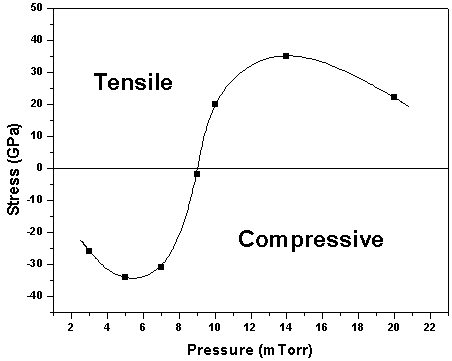
Figure 4.1: Stress dependence as function of pressure for Co-based films obtained by RF sputter deposition. [Data obtained from Materne et al (1988)].
| Growth and study of magnetostrictive FeSiBC thin films, for device applications, Mannan Ali (1999) | 51 | |
|---|---|---|
| (Online Copy) |
| Email:Mannan.Ali@physics.org | Chapter 4: Thin Film Deposition |
|---|---|
| Web: http://members.xoom.com/MannansZone/thesis.html |
for. This generally changes from being a compressive to a tensile stress as the sputtering pressure is increased. An example of such an effect is shown in Figure 4.1, where an investigation of stress in sputter deposited low magnetostrictive Co-based films was performed by Materne et al (1988) as a function of pressure. At low argon pressures, the films were found to be under compressive stress, whilst at higher pressures the stress was found to be tensile. A transition region at approximately 9mTorr existed where the stress changes sign, and the as-deposited films were found to be in a ‘stress free’ state; this also corresponded to the lowest values of the coercive field (15-30 A/m) as a function of pressure. It is the general consensus that at low pressures, the high surface mobility of the sputtered atoms promotes the formation of dense films which are under compressive stress. The compressive stress is inferred to be due to argon entrapment and lattice distortion caused by energetic incident particles. At higher pressures, the sputtered atoms are less energetic because of the increased scattering. This lowers the surface mobility of the sputtered atoms; it also causes the sputtered atoms to arrive at the substrate at more oblique angles, because of the increased scattering. This can result in the films having a columnar morphology, which induces a tensile stress in the film. The columnar growth is a result of the self-shadowing of the incident atoms by those already incorporated into the growing film [Leamy et al (1979)]. This is obviously controlled by the surface mobility of the sputtered atoms, which in turn is related to the incident energy of the sputtered atoms. As the pressure is further increased to even higher pressures, there is a reduction in tensile stress (Fig. 4.1) in the films, because of the more distinct columnar structure. The more open, columnar morphology is said to prevent the ease with which the stress can be transmitted between the columns [Hudson et al (1996)]. It has also been suggested that the tensile stress at higher pressures may be due to oxygen contamination, since there seems to be a strong correlation between oxygen incorporation and columnar growth morphology developed at high pressures [Leamy et al (1978,1979), Materne et al (1988)]. However, the effect of oxygen on stress is not clearly understood, since there have also been reports that at high pressures, oxygen incorporation leads to compressive stresses [Hoffman (1976), Hudson et al (1996)]. Similar trends due to pressure also occur on other magnetic systems such as FeCoB [Shimada et al (1981)], and FeSiB [Naoe et al (1979)] thin films which have been sputtered deposited. It should be noted that intrinsic stress from sputtering is not only confined to magnetic films and can occur in any sputter
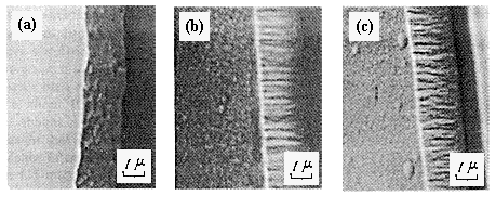
Figure 4.2: FeCoB films obtained by RF sputter deposition. Scanning electron microscopy of fractured edges of films deposited at (a) 3mTorr, (b) 50mTorr, and (c) 150mTorr indicating the development of columnar morphology at high pressures. [Data obtained from Shimada et al (1981)].
| Growth and study of magnetostrictive FeSiBC thin films, for device applications, Mannan Ali (1999) | 52 | |
|---|---|---|
| (Online Copy) |
| Email:Mannan.Ali@physics.org | Chapter 4: Thin Film Deposition |
|---|---|
| Web: http://members.xoom.com/MannansZone/thesis.html |
deposited systems, for example copper [Craig et al (1981)] or tungsten [Vink et al (1993)] films. The morphology of thin films has been summarised by Thornton et al (1974) and Craig et al (1981), where they describe various structure zones, depending on the sputtering pressure and substrate temperature. They infer that the stress and structure of the film is related to the energy of the bombarding particles at the substrate during the sputter deposition. Dense non-columnar films are obtained when the impinging particles (sputtered and reflected neutrals) have high kinetic energies (low pressures), and a distinct columnar texture is developed at low particle energies (high pressures). This is shown in Figure 4.2, where FeCoB thin films were sputter deposited by Shimada et al (1981) at various argon pressures to investigate the magnetic and structural properties. It was found that the columnar texture only appeared at high sputtering pressures (>50mTorr), and the films deposited at low argon pressures (<10mTorr) showed no characteristic structure. These results are in agreement with other studies [Naoe et al (1979), Materne et al (1988)] which also have found that films deposited at low pressures do not have any characteristic columnar morphology. It is well accepted that to obtain good magnetic amorphous films with a high saturation magnetisation and a low coercive field, the sputtering conditions need to be carefully chosen to suppress the formation of columnar growth, which is found to be unfavourable for the soft magnetic properties.
In most sputtering systems, the sputtering gas, usually argon, is allowed to flow continuously through the chamber at a constant pressure; this helps with the removal of any out-gassing impurities which could otherwise build up within the chamber and be incorporated into the depositing film. It is important that the gas flow-rate is not to excessive, since this can lead to the existence of pressure gradients within the chamber and cause non-uniform sputtering of the target, which can be reflected in a non-uniform film thickness.
4.2.2 Target-substrate separation: The separation between the target-substrate has a similar effect, as does the sputtering pressure on the growth kinetics. Increasing the separation between the target-substrate has the effect of lowering the mobility of the atoms at the substrate; the reverse is true when the separation between the target-substrate is decreased. This assumes that the sputtering power does not have total dominance over the energy of the particles. A number of studies [Hudson et al (1992,1996)] have been performed to investigate the relationship between the pressure and target-substrate separation. It has been found by Hudson et al that a relationship exists between the pressure P, the target-substrate separation, d, and the stress found in the sputter deposited films. It was reported that films deposited at low values of the product, Pd, produced films which were under a compressive state of stress, whereas films deposited at high values of the product, Pd, were under a state of tensile stress. It was inferred that the stresses present in the films were related to the energy of the bombarding particles, as discussed above for pressure.
| Growth and study of magnetostrictive FeSiBC thin films, for device applications, Mannan Ali (1999) | 53 | |
|---|---|---|
| (Online Copy) |
| Email:Mannan.Ali@physics.org | Chapter 4: Thin Film Deposition |
|---|---|
| Web: http://members.xoom.com/MannansZone/thesis.html |
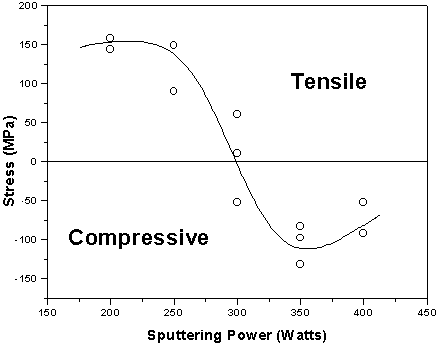
Figure 4.3: Stress dependence as function of sputtering power for tungsten films obtained by sputter deposition. [Data obtained from Wagner et al (1974)].
4.2.3 Sputtering Power: The sputtering power also has a similar effect to that of the pressure as described above. Figure 4.3 shows the variation in stress for sputter deposited films as the sputtering power is increased. It can be seen that, at low sputtering powers, the film is in a state of tensile stress, whereas the stress state of the films becomes compressive at higher powers. This is due to the increasing kinetic energies of the particles and hence surface mobility. The deposition rate increases linearly with increasing power but, from Figures 4.1 and 4.3, it is clear that to obtain stress-free films, the deposition rate is somewhat restricted by these parameters. The sputtering rate can be increased by use of a magnetron (Section 3.1.3) in conjunction with the target. This produces a denser plasma at the target surface, which increases the deposition rate without increasing the sputtering power. However, the use of low sputtering powers ensures that the system, target and substrate temperature rises are minimised.
4.2.4 Substrate temperature: The substrate temperature is very important in controlling the magnetic and structural properties of the depositing film. In the situation where there is a large difference in the thermal expansion coefficients of the depositing film and substrate, it is essential that the substrate temperature is maintained close to room temperature. This will minimise the stresses induced in the film after the deposition, as the film and substrate contract differently on cooling. The temperature of the substrate will also influence the surface mobility of the sputtered atoms, which will therefore control the structure and intrinsic stresses due to the sputtering process. The substrates are usually water-cooled through the substrate platter, but there can still be a significant increase in the temperature of the surface of the substrate, depending on the sputtering conditions, especially if the substrates are poor conductors such as glass, or they are very thick. The low sputtering pressures used during the deposition also means the thermal contact between the substrate and platter is not ideal. The increase in the surface temperature is mainly due to energetic sputtered atoms and secondary electron bombardment of the substrate. Secondary electron bombardment is significantly minimised on magnetron sputtering systems, where the electrons are captured by the magnetic field. Ounadjela et al (1987) have demonstrated that, by applying a DC magnetic field parallel to the substrate at the substrate platter, it is
| Growth and study of magnetostrictive FeSiBC thin films, for device applications, Mannan Ali (1999) | 54 | |
|---|---|---|
| (Online Copy) |

